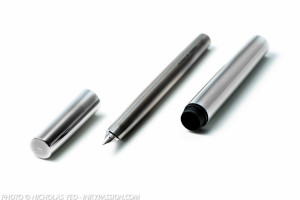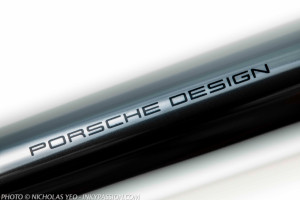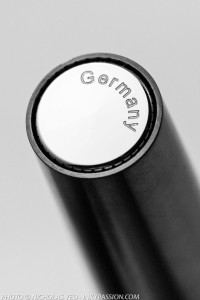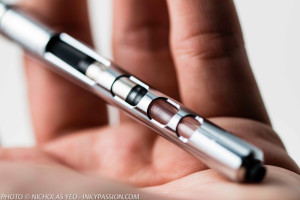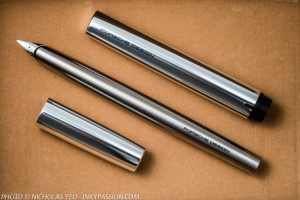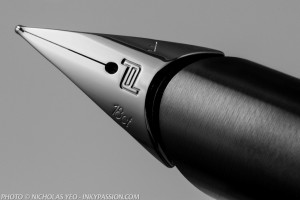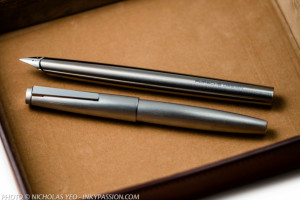Hands on with the Porsche Design P’3135 “Solid” – a titanium beast with killer looks
The Porsche Design P’3135 “Solid” is a cartridge converter-filled fountain pen which is milled from a single piece of solid titanium. At a list price of approximately €795, the regular production P’3135 epitomises understated elegance and luxury with subtle curves and a streamlined appearance.
The P’3135 also comes in a gold-plated finish at €990, as well as a numbered, Limited Edition of just 11 fountain pens in 14K solid gold. The P’3135 Limited Edition once made headlines on Forbes for its whopping €25,000 price tag.
Porsche has been designing car-related merchandise since the 1950s. The Porsche Design Studio which conceptualised the P’3135 has existed since 1972. It was established by Professor Ferdinand Alexander Porsche, grandson of the company founder and famed automobile designer of the same name.
Porsche Design, however, does not manufacture writing instruments on their own – the Porsche Design P’3135 is maufactured by Pelikan Vertriebsgesellschaft mbH & Co. in Hannover, Germany. Pelikan also manufactures the P’3130 “Tec Flex” and P’3140 “Shake Pen”, among others, which both sport ingenious operating mechanisms.
Porsche Design describes the P’3135 as having been “plasma-polished and coated with PVD” to ensure durability and a lasting finish. It says that the coating is “made of 99.99 percent pure titanium and produces a scratchproof surface which is also ten times harder than steel. ” At this price point, one shouldn’t expect any less – I did however spot some micro scratches on the titanium barrel when I received it. Those are ostensibly due to the contact between the surfaces of the casing and pen barrel.
The P’3135’s minimalist aesthetic conceals a technologically advanced filling mechanism – in order to fill the pen, the user applies gentle pressure to the top of the barrel, depressing a spring-loaded mechanism. A fluted end-piece emerges from the top of the pen, and is unscrewed to reveal a metal housing which contains a Pelikan international converter.
The cartridge – converter housing with which the pen is filled.
At first glance, the filling system on the P’3135 may be mistaken for a captive-converter system, however it is merely a housing which contains a converter or cartridge, and which regretfully serves no other purpose. While inside the housing, the converter knob cannot be operated – it has to be removed from the metal housing and filled before it is replaced.
The complicated mechanism is necessitated by the fact that the P’3135 is made of a solid piece of titanium. It is therefore impossible to attach the converter or to reach the converter knob given the length of the pen. In this case, less is more, is less – quite literally.
The design of the P’3135 may be both its strength and its undoing – although the converter housing makes it easier to fill the pen, cleaning out the pen may be challenging, because unlike a conventional fountain pen, there is no straightforward way to flush the feed with clean water. The best way to flush out the pen may be a bulb syringe, inserted into the pen barrel from behind.
The solid titanium P’3135 does not come with a cap or clip – instead, it comes with a polished aluminium travelling case which also features a plastic stopper to prevent it from rolling off a table. The travelling case serves as a protective housing, but also causes the pen to be extremely long, weighty and unwieldy. It is also susceptible to being scratched over time because of its mirror-like finish.
The P’3135 comes with a seamlessly integrated nib unit.
The P’3135 is fitted with a unique 18K gold nib. The nib is flush with the surface of the barrel, making for comfortable writing. Given the unconventional appearance of the nib, it is certainly going to cost a significant amount in the event it is damaged or needs to be replaced. The 18K gold nib is engraved with the symmetrical “PD” logo as well as the words “18ct” and “F”. It is rhodium plated to match the appearance of the barrel. The nib writes well – it is stiff but writes fairly smooth. Ink flow is moderate.
One would posit that the Porsche Design P’3135 best serves the purpose of a desk-pen. Operating it is much like an elaborate ritual – uncap the travelling case, set the short end on the table and pull the pen out of the long end. That’s if the pen is already filled. Filling its converter requires those three steps, and many more. The P’3135 is therefore a great collection piece and an even greater show piece, which will turn heads and attract compliments.
Porsche Design’s P’3135 is longer than a Lamy 2000.
The Porsche Design P’3135 in titanium retails at €795 – that translates to approximately S$1179.03 or US$860.99 at the time this article was published. Compared to other pens made of titanium, the Porsche Design P’3135 is not priced unreasonably – Nakaya’s Titanium Piccolo, for example, retails at US$1000 before shipping, which is a considerable bit more.
Unfortunately, the Pelikan distributor in Singapore does not stock this product and collectors would have to look abroad and online in order to purchase one. Given that the euro has traded at a 12-year low against the dollar, one may take advantage of the competitive exchange rates when purchasing this fountain pen.
From its minimalist curves to its seamless, uninterrupted barrel design, the P’3135 exudes a subtle charm – that of a minimalist modern quill. That being said, the P’3135 is not a practical pen for daily use. Capped, it is large and unwieldy. It also requires a complex number of actions to fill and is difficult to clean out. This makes it attractive to only the most discerning collectors and ardent followers of the Porsche brand.
PROS
– Attractive, high-tech appearance
– Seamless, uninterrupted barrel form
– Understated appearance
– Solidly constructed from titanium
CONS
– Large and unwieldy while in casing
– Complicated filling mechanism
– Not easy to flush out
– Impractical for daily use

